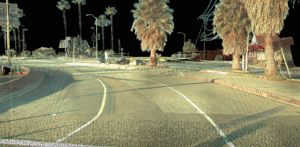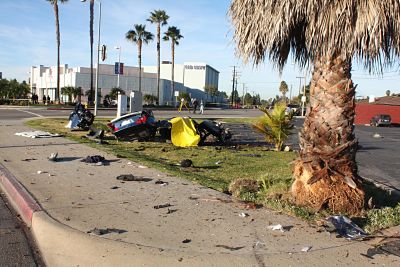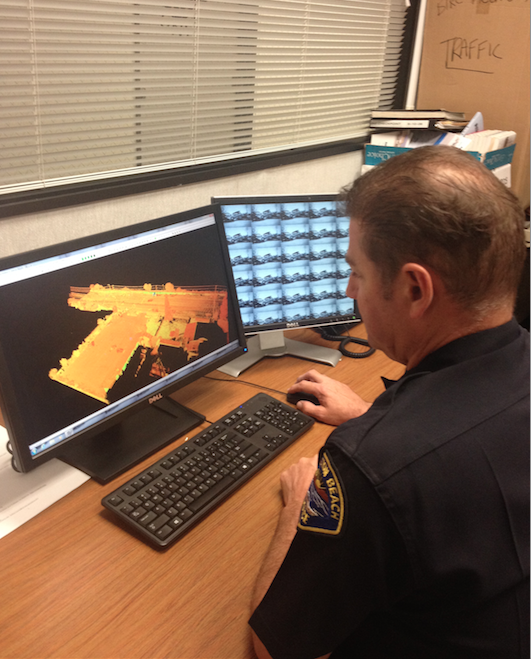“I didn’t see the pedestrian.”
“My brakes weren’t working.”
“I wasn’t speeding.”
When it comes to traffic collisions, Huntington Beach police have heard it all.
What motorists likely don’t know is the department has a specialized team equipped with high-tech tools so that they can verify it all, too.
The Huntington Beach Major Incident Reconstruction Team (MIRT) investigates all major traffic incidents, fatal crashes and even homicides.
With a rise in fatal collisions in Huntington Beach (going from nine in 2010 to 14 so far this year), Sgt. David Dereszynski said the agency has expanded its incident investigation team.
“We brought in additional skills, more technology and more experience,” Dereszynski said. “We built on what we’ve been doing over the years.”
In September 2013, two specially-trained motor officers were added to the team to support the two existing reconstruction investigators, bringing the team total to four.
A $250,000 grant helped pay for new technology and equipment which will be used to investigate serious crashes, find the cause and come up with a plan to reduce them.
“It’s a very big problem that we’re trying to make into a smaller, more manageable one,” Dereszynksi said.
There can be dozens of contributing factors in fatal collisions, such as speed, mechanical malfunctions, hazardous road conditions, and intoxicated drivers.
Whatever the cause, it is MIRT’s job to find it.
That’s when the science comes in to play.
TRAFFIC SCIENCE
Investigator Robert Barr has been investigating traffic collisions since the 1980s.

The Leica ScanStation scanner can record 4 million plot points in one shot to recreate a streetscape.
Where tape and drawings once served as the best tools to recreate a collision scene, digital scanners and computer programs now do the job.
“I took pen to paper in the old days,” Barr said. “The basic methods are still there, but we’re doing a lot more now.”
“The technology is unbelievable.”
Barr now is responsible for verifying the data collected by MIRT officers who go to the scene with a laser scanner and GPS plotter, among other tools.
The plotter is commonly used to map collision scenes using single GPS points (it’s also used in road construction by agencies such as CalTrans).
While the GPS plotter gives good information, it’s not as impressive as the Leica ScanStation laser scanner.
A GPS plotter records one point at a time, and must be moved to dozens of locations around the scene to create a streetscape.
The scan station takes 4 million plot points in one shot to create a three-dimensional image.
Huntington Beach Police and the Orange County Sheriff’s Department are the only Orange County agencies that have such technology, Dereszynski said.
Motor Officer Josh Page, a MIRT investigator trained in using the scanner, takes multiple scans, layers them together using a computer program, and creates an animation of the incident.
The program literally puts Page in the perspective of the driver’s seat and allows him to see how the collision happened.
It also lets him take accurate measurements so he can apply physics formulas on skid marks, denting and debris fallout that can help determine speed, car positioning and other possible contributing factors, he said.
“It’s almost too much information,” Page said. “You have to whittle it down to what you can use, and what you can’t use.”
Vehicle inspections after a crash help determine whether a mechanical malfunction, such as a stuck accelerator or faulty breaks, played a role.
Investigators also examine road conditions, weather, traffic light engineering, toxicology and seatbelt safety.
It can take two to four months to go through the data and wrap up a major incident investigation, Dereszynski said.
“We want to determine whether there is criminal culpability for the driver,” he said. “Most of these cases end up in criminal or civil court down the road.”
That’s why, Dereszynski added, no piece of evidence is too small.
EXAMINING A FATAL
Members of MIRT handle an average of 11 fatal traffic collisions a year, police said.
“We see things that you will never see; the worst of the worst,” Barr said. “I worked homicide and I’m telling you, there’s nothing worse than a fatal.”
Barr said fatal collisions are violent, devastating and can be traumatizing for the officers investigating them.
In some cases, Barr said maintaining some kind of sense of humor helps officers deal with the tragedy they encounter.
In others, only time can fade the harrowing images.
“Accidents involving kids, you just can’t deal with,” he said. “It took me a year to get over one.”
A 2013 double-fatal crash involving a young mother and her 18-year-old boyfriend recently was highlighted in a report to Police Chief Robert Handy as an example of the cases the team handles.
The narrative officers pieced together through their investigative strategies went something like this:
Against her parents’ wishes, the girl sneaked out of her house, grabbed the spare keys to her parents’ Honda Civic and left to meet up with her boyfriend some time after 11 p.m.
Receipts found at the collision scene told officers the two stopped to get cash at an ATM, then ordered food at a Mexican takeout restaurant in Huntington Beach.

MIRT investigated a double fatal collision in which the driver was speeding, ran a red light and crashed into a palm tree on Ellis Avenue near Beach Boulevard.
Toxicology reports showed the teens had been drinking. Marijuana also was found in their systems.
At about 5 a.m., the 18-year-old man was driving westbound on Ellis Avenue when he ran through a red light at Beach Boulevard before slamming into a palm tree.
The four-door Honda Civic exploded into three pieces.
Witness said the car did not have its headlights on.
A scanner animation of the events leading up to the collision showed the intoxicated driver was most likely traveling too fast for the road conditions on Ellis Avenue and collided with a tree.
Four dark skid marks indicated the driver lost control and the car was sideways before it hit the palm tree.
The damage to the vehicle, skid marks and scanner data concluded the driver was traveling up to 82 miles per hour.
An analysis of the street showed road conditions were normal, and an investigation of the car confirmed the Honda did not malfunction.
After months of inputting data, police are confident an intoxicated driver and speed were the main causes of the crash.
Dereszynski said his team investigates such accidents because they have a passion for it and ultimately believe their work might one day help prevent such tragedies.
“What motivates a lot of us to do this work is to identify what these common denominators are, and do what we can to educate the community,” he said.
 Behind the Badge
Behind the Badge



